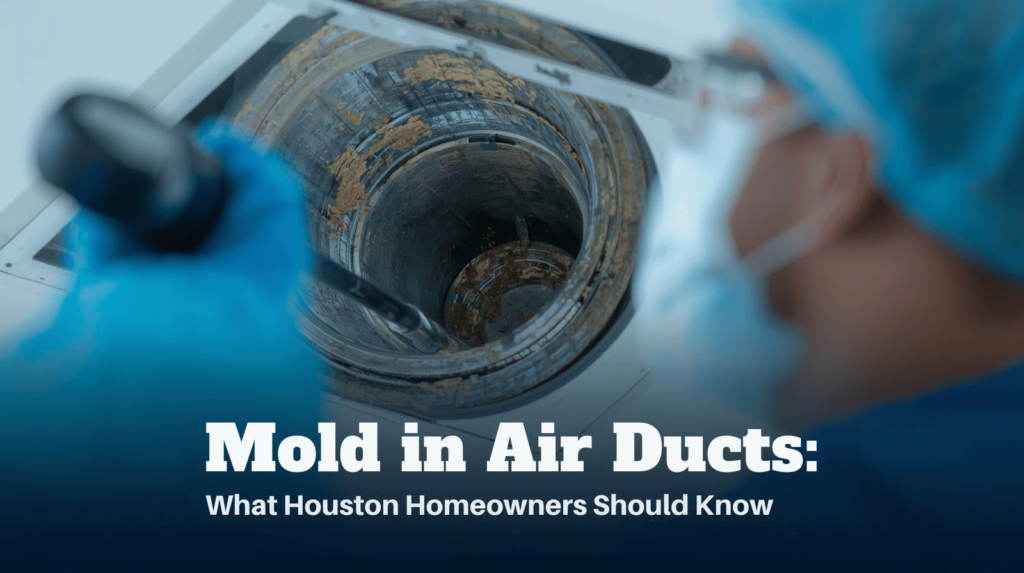Houston’s hot, humid climate creates the perfect environment for mold growth, especially inside HVAC systems. One of the most common hidden threats is mold in air ducts. Because ducts are dark, damp, and often neglected, they can become a breeding ground for mold spores that circulate throughout your home every time the AC or heater runs.
At AC Repair Houston Pros, we often get calls from worried homeowners asking: “Is there black mold in air ducts and is it dangerous?” The answer is yes—mold in ductwork is a serious issue that affects both your health and your HVAC efficiency. In this article, we’ll cover how to spot it, the dangers it poses, and how to treat mold in air ducts effectively.
Why Mold Grows in Air Ducts
Mold needs three things to thrive: moisture, warmth, and organic material. Houston provides all three:
- Humidity: Our region’s high humidity means condensation often forms inside ducts.
- Dust buildup: Dust and debris inside ducts provide “food” for mold.
- Poor ventilation: Restricted airflow prevents ducts from drying properly.
When these conditions combine, mold spores spread quickly through your HVAC system.
Signs of Mold in Air Ducts
Not sure if you have mold? Look for these signs:
- Musty odors when your AC or heater is running.
- Visible mold around vents, registers, or inside duct openings.
- Allergy-like symptoms such as sneezing, coughing, or headaches when indoors.
- Reduced HVAC efficiency—clogged ducts force your system to work harder.
If you notice any of these warning signs, call a professional for an inspection right away.
The Dangers of Black Mold in Air Ducts
Black mold in air ducts is particularly concerning because it can:
- Cause health problems: Respiratory issues, skin irritation, asthma flare-ups, and even serious infections in sensitive individuals.
- Spread quickly: Every time your system turns on, it pushes spores into your home’s air.
- Damage your HVAC system: Mold can block airflow and increase wear and tear.
This is why professional cleaning and treatment are essential when mold is detected.
How to Treat Mold in Air Ducts
If you suspect mold in your HVAC system, don’t ignore it. Here’s what you can do:
✅ 1. Professional Air Duct Cleaning
The most effective solution is professional duct cleaning. At AC Repair Houston Pros, we use advanced air duct cleaning equipment to safely remove mold, dust, and contaminants.
✅ 2. Antimicrobial Treatments
After cleaning, technicians apply a spray to kill mold in air ducts. These EPA-approved antimicrobial sprays stop spores from regrowing and sanitize your ducts.
✅ 3. Fix the Source of Moisture
Cleaning alone won’t solve the problem unless the moisture issue is fixed. That could mean:
- Sealing leaks in ductwork.
- Repairing drainage issues.
- Installing a dehumidifier to control Houston’s humidity.
✅ 4. Regular Maintenance
Enrolling in HVAC maintenance plans ensures your ducts, coils, and filters are checked regularly so mold doesn’t return.
DIY vs. Professional Treatment
You may wonder: “Can I DIY this? Can I just use a spray to kill mold in air ducts myself?”
While DIY sprays and cleaners exist, they are not recommended for duct systems because:
- Ducts are difficult to access fully.
- Mold spores spread easily if disturbed.
- Black mold exposure is a health risk.
The safest solution is to let professionals handle inspection, cleaning, and treatment.
How to Prevent Mold in Air Ducts
Prevention is always better than treatment. Here’s how Houston homeowners can reduce mold risks:
- Replace air filters every 1–3 months.
- Schedule annual AC maintenance Houston services.
- Keep humidity levels between 30–50% with a dehumidifier.
- Seal duct leaks and improve insulation.
- Clean drip pans and condensate lines to prevent standing water.
✅ FAQs: Mold in Air Ducts
1. How do I know if I have mold in my air ducts?
Look for musty odors, visible mold near vents, or worsening allergy symptoms indoors.
2. Is black mold in air ducts dangerous?
Yes. Black mold can trigger severe respiratory issues and spreads quickly through HVAC systems.
3. What spray kills mold in air ducts?
Professionals use EPA-approved antimicrobial sprays designed for HVAC systems. DIY sprays are not as effective or safe.
4. How to treat mold in air ducts long-term?
Professional duct cleaning, antimicrobial treatment, and fixing moisture issues are essential.
5. How much does mold removal from air ducts cost in Houston?
Costs vary depending on the extent of the infestation but typically range from $500 to $2,500. Preventative maintenance is always more cost-effective.


